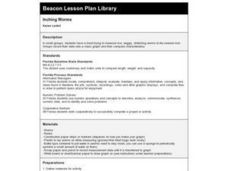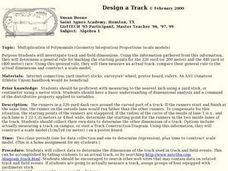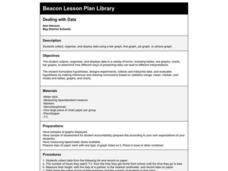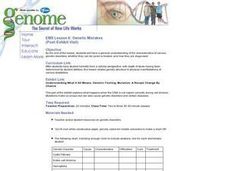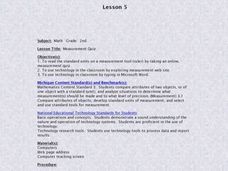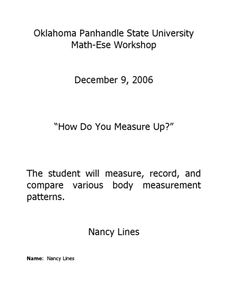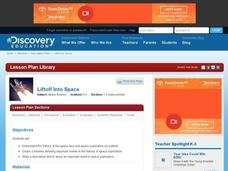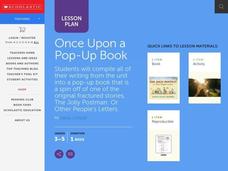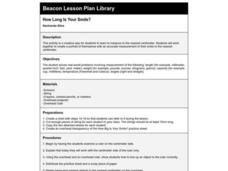Curated OER
Inching Worms
Third graders have a blast trying to measure live, wiggly, stretching worms to the nearest inch. Groups record their data onto a class graph and then compare characteristics. They share their findings with the rest of the class. Fun lesson!
NOAA
Methane Hydrates – What's the Big Deal?
Have you ever tried to light ice on fire? With methane hydrate, you can do exactly that. The ice forms with methane inside so it looks like ice, but is able to burn. The lesson uses group research and a hands-on activity to help scholars...
Curated OER
365 Days of African American History
Students use a calendar template to create a daily calendar of African American historical events. They put one event on each day of the calendar.
Curated OER
Makeshift Measuring Tools
Fifth graders practice measuring items with unique tools. In this length lesson, 5th graders examine several household items and must decide if they want to use a pencil width, piece of paper, or their thumb to measure the item....
NOAA
What's the Big Deal?
Who knew that a possible answer to Earth's energy resource problems was lurking deep beneath the ocean's surface? Part four of a six-part series introduces Earth Science pupils to methane hydrate, a waste product of methanogens. After...
Alabama Learning Exchange
How Old Is That Tree?
Fifth graders study environmental changes by examining the annual rings of a cross-section of a tree trunk. They access websites to complete a worksheet on the parts of a tree. They count the annual rings on a tree slice while observing...
NOAA
Animals of the Fire Ice
When the sun's rays can't reach the producers in a food web, where does all the energy come from? Extreme environments call for extreme food sources. Young scientists investigate creatures that appear to get their energy from methane...
Curated OER
Units and Measurement
Students discuss the word weight, how much they weigh and the conccept of heavy and light. They hear the story of measurement and the metric system. They work in groups and measure and record items found in the classroom and use a...
Curated OER
Technology Lesson Activity: Fractions
Fifth graders practice using the English measuring system by creating fractions. In this parts of a whole lesson, 5th graders combine math key bars to simulate small parts of a bigger item. Students combine the pieces to...
Curated OER
Spud Stuff
Student culminate a unit on potatoes. In this potato lesson, students make a booklet using the information acquired throughout a unit. They draw a picture of their potato, name it, measure it in inches, count its eyes, weigh their spud,...
Curated OER
Design a Track
Students investigate track and field dimensions, measure an actual track, and construct a scale model. The use of a meter stick, dimensional analysis, and the application of the distributive property to variables forms the main focus of...
Curated OER
Dealing With Data
Students collect, organize, and display data using a bar graph, line graph, pie graph, or picture graph. They write a summary describing the data represented and compare the graph to another graph in the class.
Curated OER
Try This On For Size!
Students view a video to gather information about our solar system. They create models of the planets to scale and place them in scale relative to their distances from the sun. They also visit a planetarium or use the internet to gather...
Curated OER
Genetic Mistakes
High schoolers explore genetic disorders. They examine the genetic structure to physicial manifestations of various disabilities. Using internet sources, students analyze the characteristics of genetic disorders, whether they can be...
Curated OER
Map Scale and the Pioneer Journey
Fourth graders use a map, ruler and calculato to determine the distance the pioneers traveled from Nauvoo, Ill. to the Salt Lake Valley.
Curated OER
Measurement Quiz
Second graders investigate a measurement web site before taken an online quiz about standard units of measurement. They determine how to read a ruler and take a twenty question quiz. They write about what they learned using a word...
Curated OER
How Do You Measure Up?
Students explore the concept of measurement, modelling the increments on a standard ruler using cubes and grid paper. They identify the length of a line to a designated standard unit and measure specified body parts.
Curated OER
"How Do You Measure Up?"
Fourth graders explore basic measurements by analyzing their own bodies. In this human anatomy lesson, 4th graders identify the units used to measure a human body such as centimeters, inches, ounces and pounds. Students complete a...
Curated OER
Liftoff Into Space
Students explore the history of space exploration. For this history of space exploration lesson, students create a timeline of space exploration. Students watch a space video and discuss important events. Students research space...
Curated OER
Once Upon a Pop-Up Book
Students design and illustrate a pop-up book of their original writing after studying the book, The Jolly Postman: Or Other People's Letter's. They present their book and complete a self-assessment rubric.
Curated OER
Measurement: Finding Areas of Rectangles
Gardening geometers construct the formula for the area of a rectangle by viewing a video revolving around two young people, their lawn mowing business, and their need to charge by the square meter. A relevant real-life application lesson!
Curated OER
How Long Is Your Smile?
Fourth graders measure to the nearest centimeter. They work together to create a portrait of themselves with an accurate measurement of their smile to the nearest centimeter. This is a creative way for students to explore centimeters.
Curated OER
When Turtle Grew Feathers
Young scholars explore the Choctaw Native American tribe. For this cross curriculum literacy and U.S. history lesson, students locate where the Choctaw Indians lived on a United States map. Young scholars listen to When...
Curated OER
Dino History
Students create a timeline of the times dinosaurs lived. In this dinosaur timeline lesson, students research the various periods when dinosaurs lived. Students work in groups to research the dinosaurs of a specific time...
